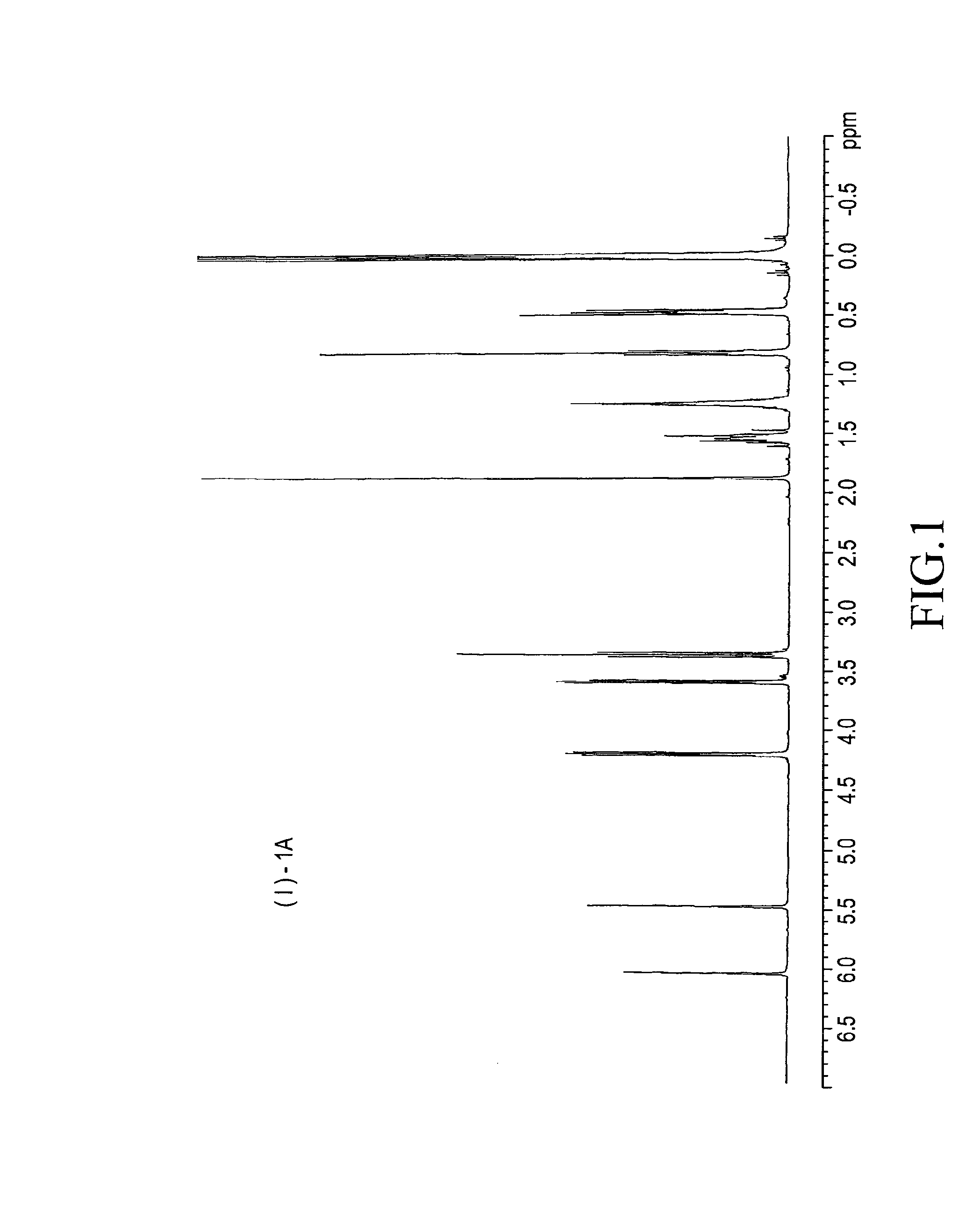Silicone compound, a process for the preparation thereof and a process for the preparation of an ophthalmic device therefrom
a technology of ophthalmic devices and compound, which is applied in the field of silicon compounds for producing ophthalmic devices, can solve the problems of insufficient oxygen transmission rate of polymers obtained from sigma, inability to obtain transparent polymers, and varied copolymers, etc., and achieves high end-blocking ratio, high purity, and high purity
- Summary
- Abstract
- Description
- Claims
- Application Information
AI Technical Summary
Benefits of technology
Problems solved by technology
Method used
Image
Examples
example 1
(i) Preparation of a Silicone Compound of the Following Formula (2*)
[0037]To a one-litter flask equipped with a Dimroth, a thermometer, and a dropping funnel were added 76.5 g (0.75 mol) of ethylene glycol monoallyl ether and 100 g of toluene and heated to 70 degrees C. To the flask was added 0.38 g of a solution of a catalyst, complex of alkali-neutralized chloroplatinic acid with vinyl siloxane, in toluene (platinum content: 0.5%). Then, 206 g (0.5 mol) of 1-butyl-9-hydro-1,1,3,3,5,5,7,7,9,9-decamethylpentasiloxane was added dropwise to the flask using the dropping funnel over one hour. The inner temperature rose up to 85 degrees C. The reaction mixture was aged at 100 degrees C. for one hour and, then, analyzed in GC. The peak of the raw material, monobutyl decamethyl hydropentasiloxane, disappeared, showing that the reaction completed. 200 g of ion exchanged water of was added to the reaction mixture. The reaction mixture was washed with with stirring, and allowed to stand still...
example 2
(i) Preparation of a Silicone Compound of Formula (4*)
[0048]Reaction was carried out as in the case of (2*) except that 109.5 g (0.75 mol) of diethylene glycol monoallyl ether was used instead of 76.5 g of ethylene glycol monoallyl ether of formula (2*). After the completion of the reaction, the reaction mixture was washed with 200 g of ion exchanged water. The separation was not enough and, therefore, water was changed with an aqueous 5% sodium sulfate solution. The toluene in the aqueous phase was stripped off under reduced pressure to obtain 240 g of the silicone compound of the following formula (4*) in a yield of 87%. The purity of the compound was 99.1% by weight as determined on GC in the afore-mentioned conditions.
[0049](ii) Preparation of a Silicone of (1*)-2A
[0050]Reaction was carried out as in the case of synthesis of (1*)-1A, except that 223.2 g (0.4 mol) of the silicone carbinol (4*) was used instead of 205.6 g of the silicone carbinol (2*). An aqueous 5% sodium sulfate...
PUM
| Property | Measurement | Unit |
|---|---|---|
| Fraction | aaaaa | aaaaa |
| Percent by mass | aaaaa | aaaaa |
| Acidity | aaaaa | aaaaa |
Abstract
Description
Claims
Application Information
 Login to View More
Login to View More - R&D
- Intellectual Property
- Life Sciences
- Materials
- Tech Scout
- Unparalleled Data Quality
- Higher Quality Content
- 60% Fewer Hallucinations
Browse by: Latest US Patents, China's latest patents, Technical Efficacy Thesaurus, Application Domain, Technology Topic, Popular Technical Reports.
© 2025 PatSnap. All rights reserved.Legal|Privacy policy|Modern Slavery Act Transparency Statement|Sitemap|About US| Contact US: help@patsnap.com



